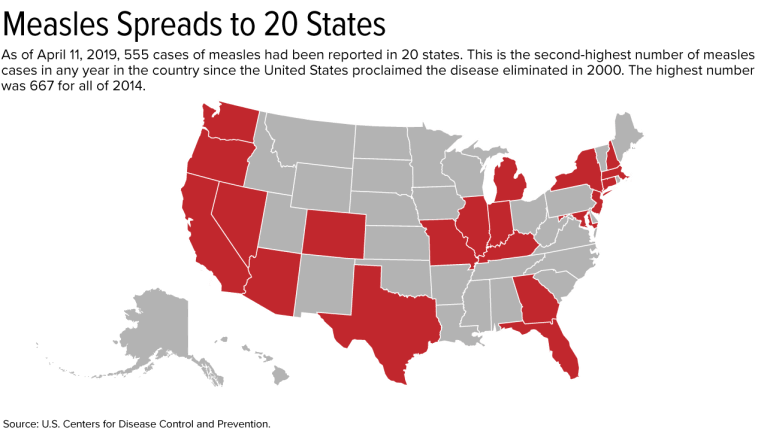What HR can do about the measles — and what it can't
According to the Centers for Disease Control and Prevention (CDC), measles has been confirmed in 26 states since the beginning of 2019, affecting not only schools, medical facilities and public areas, but also the workplace. Continue reading to learn more.
After decades of near-eradication in the U.S., measles is making a comeback. Its return affects not only schools, medical facilities and public areas, but also the workplace.
As of May 24th, there were 535 confirmed cases of measles in Brooklyn and Queens since September, according to the New York City Department of Health and Mental Hygiene. On the other side of the country, the Los Angeles Times recently reported a confirmed case of measles linked to Google's Mountain View campus.
Measles has been confirmed in 26 states since the start of 2019, as of May 24, according to the Centers for Disease Control and Prevention (CDC) — the greatest number of cases reported in the U.S. since 1994; measles was actually declared eliminated in 2000.
Given that measles is "very contagious" and can lead to serious health complications, HR needs to know how to keep employees safe while at the same time remaining in compliance with all applicable health privacy and anti-discrimination laws.
Measles transmission and symptoms
"Measles spreads when a person infected with the measles virus breathes, coughs, or sneezes," said Martha Sharan, Public Affairs Specialist at the CDC, speaking to HR Dive via email. "It is very contagious. You can catch measles just by being in a room where a person with measles has been, up to two hours after that person is gone. And you can catch measles from an infected person even before they have a measles rash."
In addition to a fever that can get high, Sharan said, other possible symptoms include cough, runny nose, and red eyes; a rash of tiny red spots that starts at the head and spreads to the rest of the body; diarrhea; and an ear infection.
Can employers require vaccinations?
In general, requiring employees to get vaccinated is a legally risky proposition for employers; there are some limited exceptions for employers in the healthcare field.
However, many employers — particularly those in the healthcare field — are "starting to be a little more aggressive in terms of asking employees whether they have been vaccinated as the [measles] outbreak continues and in some cases continues to grow," according to attorney Bradford T. Hammock, a shareholder at Littler Mendelson P.C.
"Employers must be very careful about these types of inquiries, but some healthcare employers have made the determination that this is permissible under the [Americans with Disabilities Act] as job-related and consistent with business necessity," Hammock said. He added that employers must also be aware of state and local considerations.
Steve Wojcik, VP of public policy at the National Business Group on Health, said the current concern about measles provides employers with an excellent opportunity to communicate the importance of vaccines and immunizations generally. "Remind employees that the measles vaccine is free, essentially, with no cost-sharing as it is one of the preventive services under the Affordable Care Act. It's a good reminder about preventive services in general."
Wojcik added that employers should encourage employees to check their specific vaccination records to confirm not only that they have received the measles vaccine, but that they have been effectively vaccinated. "Depending on age and when you were vaccinated, some early vaccines may not have been as effective as once thought," he said. Wojcik said that employees born in or before 1956 are assumed to have been exposed to the measles at some point and have some natural immunity, but in the early 1960s, the measles vaccine was "not so good," he said. "It's not as simple as flu or other vaccines."
If your workplace has been exposed
Whatever you do, "be incredibly careful about privacy," said attorney Carolyn D. Richmond, a partner at Fox Rothschild LLP. "Don't go announcing that 'Joe Smith has measles!'" Instead, Richmond advised, "call the local department of health first and find out what they have to say. Every jurisdiction has little tweaks that may affect reporting."
While you can send out a notice to employees stating they may have been exposed to measles, "again, be super careful and don't hint who it might be," she cautioned. "Your local health department will be able to tell you what you can say."
Get your leave policies in order
"Those sick with measles should stay at home for at least four days after developing the rash," said Sharan. "Staying home is an important way to not spread measles to other people. They should talk to their doctor to discuss when it is safe to resume contact with other people."
Wojcik recommended working from home and flexible work arrangements for employees who may have been exposed, particularly those who live in (or have traveled to) areas with known outbreaks. Richmond also suggested providing PTO or work-from-home arrangements for employees who have not been vaccinated or who are immunocompromised.
"We assume that those with measles will absent themselves from the workplace, and an employee with measles may be out for a number of days or longer. Follow your policies and practices with return to work," Richmond told HR Dive in an interview.
Stay in touch with your local health department and the CDC
"Continue to be in contact with your local health department, and follow along with the CDC in terms of guidance," advised Hammock. "Depending on the status of the measles outbreak in your particular area, the analysis may be different."
Richmond concurred. "Contact your local health department and your local counsel — and contact your local health department first. The bottom line is privacy, privacy, privacy."
SOURCE: Carsen, J. (29 May 2019) "What HR can do about the measles — and what it can't" (Web Blog Post). Retrieved from https://www.hrdive.com/news/what-hr-can-do-about-the-measles-and-what-it-cant/555219/
Do career fairs still have value?
Are you participating in career fairs? Now more than ever, employers need to sell themselves to their potential hires. Continue reading this blog post to learn if career fairs still add value to recruiting.
In today's tight applicant market, job seekers are in charge. To meet their demands, recruiters have set aside old red flags and even some traditional sourcing methods. But do career fairs still make the cut?
Candidates want to be courted and, now more than ever, employers need to sell themselves to potential hires. Many young candidates, in particular, hope to land at a cutting-edge company — and a booth at a job fair may seem a bit old fashioned unless employers make a few modifications. Though a career fair is not always enough on its own, many employers have found ways to use this old-school technique to send today's job seekers the right messages about their organizations.
Do career fairs actually net hires?
Vicki Salemi, career expert for Monster, doesn't think job fairs are an effective use of employer resources. "Generally speaking, career fairs — as a standalone — do not net talent," she told HR Dive in an email. "For the job seeker, it can be challenging to stand out among stacks of resumes and, for the employer, it's not time well spent." A former financial services corporate recruiter, she said she rarely made a hire from a fair.
But they can be useful for specific industries, roles and skill sets, she added. Employers can maximize the potential of a job fair by using them in conjunction with other innovative hiring solutions as part of an integrated hiring mix. "One way employers can maximize their time at a career fair is to pre-screen resumes of candidates so that they can arrange on-site interviews," Salemi said.
Mike Cooke, account executive at Montage, said that the traditional career fair has become outdated. "Consider the amount of time and money that is typically spent on a traditional career fair," he said to HR Dive in an email. Costs can include sponsorship fees, travel expenses and swag, plus the amount of time recruiters are spending at the event and sifting through resumes received — often with little positive return on investment. "Additionally, if a company isn't able to engage candidates' pre-event, the recruiter could very well be spending face to face time with a candidate that isn't a fit," he added.
Fairs can be a challenge for candidates, as well, Salemi said: "It's often hard to make an impact with a 30-second introduction to each employer — and that can be draining." Generally, recruiters should look at the career fair as only one aspect of their hiring toolkit.
Raising awareness instead of reaping resumes
For many businesses, career fairs offer an opportunity to showcase what they do and how job seekers can be a part of the team. They can illustrate what may be available to both students and those looking to change their career trajectory, particularly for employers offering jobs that do not require a traditional degree. For organizations not known as a hiring player in certain disciplines, especially tech, exposure can offer options. At a tech-oriented career fair, employers who may not have been considered in the past by any tech workers can entice them to look closer to home before jockeying for a slot in Silicon Valley.
"Career fairs are a valuable way to drive awareness for companies across a large subset of potential talent," Mike Rogers, senior director of maintenance and refrigeration at Tyson Foods, told HR Dive in an email. For Rogers, awareness is invaluable; industrial maintenance, a trade specialty with 85 different skills, has a critical skills gap. Nearly 40% of his maintenance and refrigeration hourly team members are 50-years old or older, keeping his team on the hunt for ways to build out the talent pipeline for trade-focused jobs.
Tech takes career fairs to the next level
To offer today's job seeker the recruiting experience they want, virtual career fairs are taking off. Connecting through video saves candidates and employers time and money. Individual connections are made in a private setting, without others vying for attention. These types of fairs cast a wider net to help meet inclusion efforts as well, Cooke said. "Virtual career fairs allow recruiters to reach a larger and more diverse pool of candidates — including students located on smaller and more rural campuses — that they wouldn't normally have access to due to time, cost and travel restrictions."
Joe Milner, talent acquisition manager at Pearson, worked with Montage's recruiting technology for their own virtual career fair. To attract a more diverse level of qualified entry-level talent, their hiring managers were able to interview a number of candidates at a quick pace. "Because they were able to talk with such a wide variety of candidates, our hiring managers were able to make job offers to candidates they normally wouldn't have spoken with or even considered at a traditional job fair or through other recruiting tactics," Milner said in an email.
The other experts agreed. Virtual career fairs save time and money and can be an effective way for employers and job seekers to connect, Salemi said, and while they don't work well as a stand-alone strategy, an integrated hiring mix is incomplete without them. Gen Z candidates are digital natives, so meeting these job seekers where they're already living — on their mobile devices and laptops — will be the best approach in attracting them to your company, Cooke added.
SOURCE: O'Donnell, R. (20 May 2019) "Do career fairs still have value?" (Web Blog Post). Retrieved from https://www.hrdive.com/news/do-career-fairs-still-have-value/554107/
Bad Relationship with Your Boss? How to Fix it
Do you have a poor relationship with your manager? Often, poor relationships with managers can be detrimental to both the work employees' produce and their quality of life. Read this blog post from SHRM for tips on how to repair your relationship with your boss.
A poor relationship with your manager can be detrimental: both in the work you produce and your quality of life. LaSalle Network COO, Maureen Hoersten, uncovers ways to get to the root of bad relationships at work, and tangible tips to repair them, including:
Signs you have a bad relationship with your manager:
There are common signs your relationship may be less than healthy like disengagement and short communication. Ask yourself: has something changed? Are you getting less feedback or training as you did before, or is the opposite true and you’re suddenly being micromanaged? Evaluate how the relationship is evolving to determine if it’s going down the right path.
Determining the source of the problem:
The key to getting to the root of the relationship issue is to communicate. For instance, you may think something’s going on at work, but it the issue could really lie in your personal life. Whether it’s health related or a family issue, you may be bringing it into work with you, causing you to overanalyze the relationship with your boss. On the flip side, personal factors could be affecting your boss! The less time and attention they’re providing may have more to do with their personal stressors than your work. But you won’t know until you communicate.
Have a one on one and ask if you’re not hitting expectations. Try to open up and be vulnerable to pinpoint where the problem is. It may have nothing to do with you and your work, but you must overcommunicate to get to the root of the problem.
How to fix the relationship:
Not only can the problem be determined by communication, it can be solved. They key is not just to communicate, but overcommunicate. For instance, if you’re working on a project with deadlines, consider (over) communicating the process as you go. Instead of waiting till it’s complete, give an email update or leave a voicemail with your progress. In other words- go above and beyond, exceeding expectations for communication. When your boss is running multiple groups or has a lot going on, little updates go a long way. No one wants to be left in the dark, and overcommunication can help your manager keep you on track as you go.
To mend a poor relationship with your boss, ask what you can do to get better. If it’s due to the quality of your work, what courses can you take, or books can you read to improve? Ask yourself: are you approachable, do you overcommunicate, do you come to the office a bit earlier or stay later to show that you care? If your boss doesn’t think you’re committed, show them that you can go above and beyond.
If you feel you’re being micromanaged, you may need to dig deep and think about why your boss is micromanaging you. Is there an issue with the quality of your work or hitting deadlines? Are you meeting and exceeding expectations? You need to know how you are performing before you can move on.
When to look elsewhere:
If you’ve done everything you can to repair the relationship, given it time and nothing’s changed. Evaluate whether it’s time to move on. When it’s starting to affect your personal life, you keep asking the same questions with no acknowledgment or results, you may not be in the right position. Even if you feel it may not be the right place for you, try to give it time. Mending relationships with a manager may not be an overnight fix. People can turn relationships around; you just have to make sure you’re in alignment with your boss and their expectations through effective communication.
Originally posted on LaSalle Network blog.
SOURCE: Hoersten, M. (19 May 2019) "Bad Relationship with Your Boss? How to Fix it" (Web Blog Post). Retrieved from https://blog.shrm.org/blog/bad-relationship-with-your-boss-how-to-fix-it
How do you know when learning programs are working?
How do employers measure the success of employee learning programs? The demand for employee learning programs is increasing, as well as the spend that employers are allocating for these programs. Continue reading to learn more.
Demand for learning is up and the spend that employers allocate to it is climbing — but as employers spend more money, they may also need to increase expectations for learning's success.
What outcomes do employers expect from learning programs? Whenever a company initiates training, that company must also ensure it has clear, definable results in mind, experts told HR Dive. Training to increase practical knowledge — how to utilize equipment, for example — should be task-oriented and measurable. Other training goals, like developing soft skills, may be more intangible, but success metrics can still be necessary.
Quantifying learning and finding success
The classic Kirkpatrick Model to evaluate training is widely used, Tom Griffiths, CEO and co-founder of Hone, explained to HR Dive. It covers four measurements:
- Reaction. Were workers actively engaged and participating in the program? Observation and reaction surveys can help with this metric.
- Actual learning. Did they come away from the session knowing more than they went in knowing? Baseline quizzes before and after give a snapshot of whether or not the session met objectives.
- Behavioral change. Are you seeing a change in the way people perform their work? If training isn't directly relatable and usable, this might be more difficult to quantify.
- Results. What is the final impact on the business overall following the training? Have errors decreased? Has productivity increased? Is customer satisfaction up? These measurements may take longer to quantify, but they're worthwhile metrics to obtain.
Ultimately, employers should keep an eye out for true measures of performance improvement, Anna Robinson, CEO of Ceresa, told HR Dive in an email. Sales growth, unit cost reductions and improved throughput are all examples of potential results. "If business performance improves, that means the right person is receiving the right content, and it is having an impact on their performance," she added.
But there are other ways to measure success, Ujjwal Gupta, co-founder and COO of BenchPrep, told HR Dive in an email. A learner getting that long-sought promotion or spreading knowledge in their department are key ways to witness a development program's success, Gupta said.
Changing minds and habits
What is the goal of training — changing minds or changing behaviors? Griffiths believes both are needed for a growth mindset, but one can lead to another.
"We can inspire change by giving learners the mental models, evidence and ways of thinking to start shifting their mindset, which can have a huge effect on behavior," he said. "For example, how differently do I behave if I believe I know everything and have nothing to learn from others, versus the mindset that I have something to learn from everyone?"
Employers should do more than just encourage learning, but should aspire to have a culture of learning, which enables employees to actively look for growth because learning is readily available and development is rewarded. For Griffiths, a successful learning culture is one that is open, aware and flexible. Ideally, there is a balance between dictating what the organization wants people to learn and giving the learners choice and control over what they learn to foster an employee-driven culture of learning, he noted.
Robinson said to look for engagement and buy-in. To gauge success of their mentoring program, for example, Ceresa looks at the number of women who are interested in continuing the relationship as well as the number who begin to mentor others. "This both extends and expands the learning culture," she said.
Has it made an impact?
Employees may be participating in learning exercises, but that doesn't necessarily translate to impact, experts warned. Knowledge can keep employees on track for what they need to be doing today, but it isn't enough on its own to ready them for new challenges or spark innovation. Seeing strong numbers on employee engagement surveys and significant changes in the way people work are key indicators, but the real goal is for employees to be hungry for more. Experts have noted that offering training outside workers' current areas of expertise and comfort zones can help push them further. Training that regards growth as the goal, whether or not it's of use at work today, can have the most impact on the employee and organization.
For Gupta, the numbers are important; evaluating retention and growth are leading indicators for those seemingly outside opportunities. "Seeing that you are not only keeping your employees happy, but that you are also expanding the business leads to a win-win situation by having a great learning culture that drives ROI," he said.
SOURCE: O'Donnell, R. (7 May 2019) "How do you know when learning programs are working?" (Web Blog Post). Retrieved from https://www.hrdive.com/news/how-do-you-know-when-learning-programs-are-working/554099/
Workforce Planning Will Help You Understand the Needs of Your Organization
How are you managing your workforce? Workforce planning is one of HR's most important priorities, but many HR professionals shy away from the task. Continue reading this post from SHRM to learn how workforce planning will help HR departments understand the needs of their organization.
Managing headcount—and workforce planning overall—is one of HR's most important priorities, yet so many HR and talent acquisition (TA) leaders shy away from it.
"Very few TA organizations do it, because it's a very analytical process that scares HR," said Jeremy Eskenazi, SHRM-SCP, managing principal of Riviera Advisors, a Long Beach, Calif.-based talent acquisition consulting and training company. "It's perceived to be outside of HR's expertise, and it involves inputs that come from outside HR's ownership."
In many organizations, headcount forecasting is understood to be a financial and budgeting exercise owned by finance, Eskenazi said. "But because the function of headcount is not perceived to be owned by HR, and finance doesn't make it a priority, nobody owns it in the end."
The TA function's failure to successfully predict talent gaps and prepare for hiring needs can be chalked up to a lack of experience with workforce planning, a lack of capacity to undertake it and not understanding its benefits, said John Vlastelica, founder and managing director of Recruiting Toolbox, a global management consulting and training firm in Seattle.
"Most TA leaders operate in a transactional environment and unfortunately see their jobs as purely a fulfillment function," he said. "TA is dealing with so much need that it can't help but be reactive. There's not enough time spent with the business, outlining hiring goals, conducting quarterly business reviews, updating turnover forecasts, reviewing talent composition, going over succession planning, or starting proactive sourcing conversations."
The organizations that win at talent acquisition are those that have a pipeline of talent ready to choose from when they need it, Eskenazi said. "The only way to have that ability is to know what is coming up. If you don't know what's coming up, you're operating on assumptions."
Workforce planning connects recruiting, hiring, employee development and talent management by identifying needed skills, helping recruiters target the right candidates with those skills and assisting managers in charting the internal pathways for employee growth.
"Workforce planning is not just about hiring new people; it's [also] about the gaps between what you currently have and what you need," Eskenazi said. "If you do it right, you can discover who is capable of stepping into new roles with training and development, and who may not be able to stay on in a job because the required skill sets are changing. Workforce planning is about all movement—up, down, in, out or across the organization."
Creating a Workforce Plan
The process begins with information gathering. "You simply need to interview managers of individual workgroups inside your organization and then consolidate and analyze that data," Eskenazi said. HR should be the facilitator of the process and everyone who leads people should participate, he said.
Vlastelica outlined a top-to-bottom approach to collect the information. He advised HR to sit in on executive-level discussions on overall growth and industry challenges. "At the middle level there is a lot of work to be done on forecasting for expected growth and backfills and which job families and roles are most critical," he said. To represent the bottom, "HR should talk with individual hiring managers and department leaders about their talent priorities and workforce composition," he said.
Eskenazi explained that HR should ask department heads a series of standard questions:
- How will the business impact you over the next six months? Twelve months? Twenty-four months?
- What skills do you need to meet your goals and how does current staff meet that need?
- Who is expected to be let go? Who is expected to remain? Who is getting promoted?
After gathering and tracking information about each department's talent inventory and their future talent requirements—using a spreadsheet or a workforce planning platform—it's time to conduct a gap analysis. Estimate what types of positions, people and competencies will be needed in the future to help the organization address talent gaps and then align necessary resources.
When presenting a final analysis to leadership, don't just repeat what you heard. Categorize the findings in a way that makes sense for talent acquisition, Vlastelica said.
"Forecasting is a little bit of science and a lot of art," he added. "It's a good opportunity to teach the business about how to think about talent acquisition, the ramp up time and resource cost to meet business need."
Be Flexible
Organizations looking to be more agile in a rapidly changing environment should engage in regular workforce planning updates, Eskenazi said. "All you have to do is create the framework once, then update it every six months. Once you do it one time in a comprehensive way, it's far easier than having to start from scratch."
The workforce planning team should reach out routinely for insights from department and business line leaders to update and modify the plan based on hiring needs.
"It needs to be very flexible, because oftentimes the business's priorities change, even in a short time," Eskenazi said. "The business is constantly resetting—and faster than ever before."
SOURCE: Maurer, R. (13 May 2019) "Workforce Planning Will Help You Understand the Needs of Your Organization" (Web Blog Post). Retrieved from https://www.shrm.org/resourcesandtools/hr-topics/talent-acquisition/pages/workforce-planning-will-help-you-understand-organization-need.aspx
How to Respond to the Spread of Measles in the Workplace
How should employers respond to the spread of measles? With measles now at its highest number of cases in one year since 1994, employers are having to cooperate with health departments to fight the spread. Read this blog post from SHRM to learn more.
Employers and educators are cooperating with health departments to fight the spread of measles, now at its highest number of cases in one year since 1994: 764.
Two California universities—California State University, Los Angeles (Cal State LA) and the University of California, Los Angeles (UCLA)—recently quarantined staff and students at the request of local health departments.
In April at Cal State LA, the health department told more than 600 students and employees to stay home after a student with measles entered a university library.
Also last month, UCLA identified and notified more than 500 students, faculty and staff who may have crossed paths with a student who attended class when contagious. The county health department quarantined 119 students and eight faculty members until their immunity was established.
The quarantines ended April 30 at UCLA and May 2 at Cal State LA.
Measles is one of the most contagious viruses; one measles-infected person can give the virus to 18 others. In fact, 90 percent of unvaccinated people exposed to the virus become infected, the U.S. Centers for Disease Control and Prevention (CDC) notes.
Action Steps for Employers
Once an employer learns someone in the workplace has measles, it should immediately send the worker home and tell him or her not to return until cleared by a physician or other qualified health care provider, said Robin Shea, an attorney with Constangy, Brooks, Smith & Prophete in Winston-Salem, N.C.
The employer should then notify the local health department and follow its recommended actions, said Howard Mavity, an attorney with Fisher Phillips in Atlanta. The company may want to inform workers where and when employees might have been exposed. If employees were possibly exposed, the employer may wish to encourage them to verify vaccination or past-exposure status, directing those who are pregnant or immunocompromised to consult with their physicians, he said.
Do not name the person who has measles, cautioned Katherine Dudley Helms, an attorney with Ogletree Deakins in Columbia, S.C. "Even if it is not a disability—and we cannot assume that, as a general rule, it is not—I believe the ADA [Americans with Disabilities Act] confidentiality provisions cover these medical situations, or there are situations where individuals would be covered by HIPAA [Health Insurance Portability and Accountability Act]."
The employer shouldn't identify the person even if he or she has self-identified as having measles, Mavity noted.
Shea said that once the person is at home, the employer should:
- Inform workers about measles, such as symptoms (e.g., dry cough, inflamed eyes, tiny white spots with bluish-white centers on a red background in the mouth, and a skin rash) and incubation period—usually 10 to 12 days, but sometimes as short as seven days or as long as 21 days, according to the CDC.
- Inform employees about how and where to get vaccinations.
- Remind workers that relatives may have been indirectly exposed.
- Explain that measles exposure to employees who are pregnant or who might be pregnant can be harmful or even fatal to an unborn child.
- Explain that anyone born before 1957 is not at risk. The measles vaccine first became available in 1963, so those who were children before the late 1950s are presumed to have been exposed to measles and be immune.
Employers may also want to bring a health care provider onsite to administer vaccines to employees who want or need them, Shea said.
"Be compassionate to the sick employee by offering FMLA [Family and Medical Leave Act] leave and paid-leave benefit options as applicable," she said.
When a Sick Employee Comes to Work Anyway
What if an employee insists on returning to work despite still having the measles?
Mavity said an employer should inform the worker as soon as it learns he or she has the measles to not return until cleared by a physician, and violating this directive could result in discipline, including discharge. A business nevertheless may be reluctant to discipline someone who is overly conscientious, he said. It may opt instead to send the employee home if he or she returns before being given a medical clearance.
The employer shouldn't make someone stay out longer than is required, Helms said. Rely instead on the health care provider's release.
SOURCE: Smith, A. (9 May 2019) "How to Respond to the Spread of Measles in the Workplace" (Web Blog Post). Retrieved from https://www.shrm.org/resourcesandtools/legal-and-compliance/employment-law/pages/how-to-respond-spread-measles-workplace.aspx
4 Simple Reasons Why Texting Can Lead to Better Hires
Are your recruiters continually getting “ghosted” by job candidates? The way they communicate with job recruits may have something to do with why they are getting “ghosted” by candidates. Continue reading for four reasons texting can lead to better hires.
It’s no secret that recruiters spend the majority of their time researching to find the right candidates for the right job, and even more time reaching out to talk to these potential candidates. So it’s natural that they become frustrated when candidates ignore communications like emails and LinkedIn InMail messages from recruiters. While these communication methods can work for some, they definitely aren’t preferred for all — especially these days.
With people busier than ever before, especially passive millennial candidates, recruiters are seeing more and more recruits “ghosting” them. If you are continually getting no responses to your outreach, it likely has something to do with the other 100-plus emails that are hitting candidates’ inboxes every day. Reaching out via SMS (text messaging) can help you break through the noise and make it easy for potential candidates to take the next step.
Here are four simple ways to use text messages to make better hires:
Texting is quicker
In a highly competitive market, speed matters more than ever. How quickly you can secure the talent you need impacts how quickly your business is moving forward. Seventy-three percent of U.S. millennials and Gen Zers interact with each other digitally more than they do in real life. If you want a fast answer, texting is the way to go.
Scheduling via text is also quicker
Nothing good ever comes from never-ending email chains, especially when the topic is as dull as “Are you available Wednesday morning between 9 am and 11 am?” Sending your candidate a link to your favorite scheduling client via SMS puts an end to group-email fatigue and gets the interview on the books in a matter of minutes.
Don’t forget reminders
There’s nothing worse than a candidate showing up late or missing an interview.
A quick text message is a perfect way to give your candidates a quick heads-up, give them an extra tip, a quick pat on the back and send them in ready to win. No one likes tardiness and no-shows. A quick reminder ensures everyone’s on the same page.
Accelerate the hiring process
Text messages make the candidate experience way more enjoyable by simply shortening the hiring process. Hiring typically involves emails, scheduling, and so much admin. A great SMS can make hiring human again, not to mention faster. By communicating directly with someone at a time that works best for them, especially in a way that they’re much more likely to respond quickly, it will help shorten the overall hiring timeline.
When used alongside other awesome tools, such as a chatbot, text messaging could even help qualify leads more quickly and immediately put you in touch with the best candidates.
The bottom line: utilizing text for recruiting can help you revitalize your talent pipeline and create a more engaging candidate experience.
SOURCE: Bounds, D. (25 April 2019) "4 Simple Reasons Why Texting Can Lead to Better Hires" (Web Blog Post). Retrieved from https://hrexecutive.com/4-simple-reasons-why-texting-can-lead-to-better-hires/
Employers Must Report 2017 and 2018 EEO-1 Pay Data
The Equal Employment Opportunity Commission (EEOC) is requiring that all employers report their pay data, broken down by race, sex and ethnicity, from 2017 and 2018 by September 30. Continue reading this post from the SHRM to learn more.
The Equal Employment Opportunity Commission (EEOC) has announced that employers must report pay data, broken down by race, sex and ethnicity, from 2017 and 2018 payrolls. The pay data reports are due Sept. 30.
Employers had been waiting to learn what pay data they would need to file—if any at all—as litigation on the matter ensued. A federal judge initially ordered the EEOC to collect employee pay data for 2018. The National Women's Law Center (NWLC) and other plaintiffs wanted the EEOC to collect two years of data, as the agency was supposed to under a new regulation before the government halted the collection in 2017.
Judge Tanya Chutkan of the U.S. District Court for the District of Columbia sided with the plaintiffs and gave the EEOC the option of collecting 2017 pay data along with the 2018 information by the Sept. 30 deadline or collecting 2019 pay data during the 2020 reporting period. The EEOC opted to collect the 2017 data.
The agency said it could make the collection portal available to employers by mid-July and would provide information and training to employers prior to that date.
Immediate Steps
"We are awaiting confirmation from the EEOC or the contractor it is hiring to facilitate the pay-data collection on how to lay out the data file for a batch upload," said Alissa Horvitz, an attorney with Roffman Horvitz in McLean, Va.
But employers should take some steps immediately. They should reach out to their subject-matter and technical experts and pull together resources to ensure that the required data components can be captured, analyzed and reported by Sept. 30, said Annette Tyman, an attorney with Seyfarth Shaw in Chicago.
Filing the additional reports will impose unanticipated burdens for HR, IT and legal departments, as well as third-party consultants, she noted. "It is unclear whether any further litigation options will impact the Sept. 30 deadline, and we are instructing employers to assume they must comply."
Employers should keep in mind that they still must submit their 2018 data for Component 1 of the EEO-1 form by May 31, unless they request an extension. Note that the EEOC recently shortened the extension period for employers to report Component 1 data from 30 days to two weeks. So the extension deadline is now June 14.
Component 1 asks for the number of employees who work for the business by job category, race, ethnicity and sex. Component 2 data—which includes hours worked and pay information from employees' W-2 forms by race, ethnicity and sex—is the subject of the legal dispute.
Data Collection
Businesses with at least 100 employees and federal contractors with at least 50 employees and a contract with the federal government of $50,000 or more must file the EEO-1 form. The EEOC uses information about the number of women and minorities companies employ to support civil rights enforcement and analyze employment patterns, according to the agency.
The revised EEO-1 form will require employers to report wage information from Box 1 of the W-2 form and total hours worked for all employees by race, ethnicity and sex within 12 proposed pay bands.
The reported hours worked should show actual hours worked by nonexempt employees and an estimated 20 hours per week for part-time exempt employees and 40 hours per week for full-time exempt employees.
"Filling out the added data in the EEO-1 form will present a large amount of work, especially as there's great potential for human error when populating the significantly expanded form," said Arthur Tacchino, J.D., chief innovation officer at SyncStream Solutions, which provides workplace compliance solutions.
Employers should start looking at their data now and conduct an initial assessment of their systems, said Camille Olson, an attorney with Seyfarth Shaw in Chicago. Identify the systems that house the relevant demographic, pay and hours-worked data and determine how to pull the information together, she said.
Pulling EEO-1 data is much simpler for Component 1, she noted, because it only involves reporting the employer's headcount by race, ethnicity and sex—whereas collecting pay information involves more data points. Additionally, employers may use different vendor systems at different locations, some employees may have only worked for part of the year, and other employees may have been reclassified to exempt or nonexempt.
"Employers may want to inquire with their current vendors—payroll or otherwise—or look for outside vendors that may be able to assist them with this reporting requirement," Tacchino said.
Under some circumstances, employers may be able to seek an exemption (at the EEOC's discretion) if filing the information would cause an undue burden. "Mega employers" may not be able to show an undue burden, but this could be an option for smaller businesses, said Jim Paretti, an attorney with Littler in Washington, D.C. But that will depend on how the parties decide to move forward.
The Court Battle
The EEO-1 form was revised during President Barack Obama's administration to add the Component 2 data, but the pay-data provisions were suspended in 2017 by President Donald Trump's administration. The NWLC challenged the Trump administration's hold on the pay-data collection provisions, and on March 4, Chutkan lifted the stay—meaning the federal government needed to start collecting the information.
On March 18, however, the EEOC opened the portal for employers to submit EEO-1 reports without including the pay-data questions. Chutkan subsequently told the government to come up with a plan.
The EEOC proposed the Sept. 30 deadline for employers to submit Component 2 data, claiming that the agency needed more time to address the associated collection challenges. Furthermore, the EEOC's chief data officer warned that rushing the data collection may yield poor quality data. Even with the additional time, the agency said it would need to spend more than $3 million to hire a contractor to provide the appropriate procedures and systems.
Robin Thurston, an attorney with Democracy Forward and counsel for the plaintiffs, said at an April 16 hearing that the plaintiffs don't want the agency to compromise quality. But they also wanted "sufficient assurances" that the EEOC will collect the data by Sept. 30.
On April 25, Chutkan ordered the government to provide the court and the plaintiffs with periodic updates on the EEOC's progress and to continue collection efforts until a certain threshold of employer responses has been received.
SOURCE: Nagele-Piazza, L. (2 May 2019) "Employers Must Report 2017 and 2018 EEO-1 Pay Data" (Web Blog Post). Retrieved from https://www.shrm.org/resourcesandtools/legal-and-compliance/employment-law/pages/eeo-1-pay-data-report-2017-2018.aspx
Can Employers Require Measles Vaccines?
Can employers require that their employees get the measles vaccine? The recent measles outbreak is raising the question of whether employers can require that their workers get the vaccine. Read this blog post from SHRM to learn more.
The recent measles outbreak, resulting in mandatory vaccinations in parts of New York City, raises the question of whether employers can require that workers get the vaccine to protect against measles, mumps and rubella (MMR) or prove immunity from the illness.
The answer generally is no, but there are exceptions.
Offices and manufacturers probably can't require vaccination or proof of immunity because the Americans with Disabilities Act (ADA) generally prohibits medical examinations—unless the employer is in a location like Williamsburg, the neighborhood in Brooklyn where vaccinations are now mandatory. Health care providers, schools and nursing homes, however, probably can require them because their employees work with patients, children and people with weak immune systems who risk health complications from measles.
But even these employers must try to find accommodations for workers who object to vaccines for a religious reason or because of a disability that puts them at risk if they're vaccinated, such as having a weak immune system.
Proof of Immunity
Proof of immunity includes one of the following:
- Written documentation of adequate vaccination.
- Laboratory evidence of immunity.
- Laboratory confirmation of measles.
- Birth before 1957. The measles vaccine first became available in 1963, so those who were children before the late 1950s are presumed to have been exposed to measles and be immune.
Measles, which is contagious, typically causes a high fever, cough and watery eyes, and then spreads as a rash. Measles can lead to serious health complications, especially among children younger than age 5. One or two out of 1,000 people who contract measles die, according to the U.S. Centers for Disease Control and Prevention.
Outbreak Has Spread to 20 States
As of April 11, 555 cases have been reported in the United States this year. This is the second-greatest number in any year since the United States proclaimed measles eliminated in 2000; 667 cases were reported in all of 2014.
On April 9, New York City Mayor Bill de Blasio declared a public health emergency in Williamsburg, requiring the MMR vaccine in that neighborhood. Those who have not received the MMR vaccine or do not have evidence of immunity may be fined $1,000.
Since the outbreak started, 285 cases have been confirmed in Williamsburg, including 21 hospitalizations and five admissions to intensive care units.
If a city requires vaccinations, an employer's case for requiring them is much stronger, said Robin Shea, an attorney with Constangy, Brooks, Smith & Prophete in Winston-Salem, N.C. But employers usually should not involve themselves in employees' health care unless they are making an inquiry related to a voluntary wellness program, or the health issue is job-related, she cautioned.
The measles outbreak has spread this year to 20 states—outbreaks linked to travelers who brought measles to the U.S. from other countries, such as Israel, Ukraine and the Philippines, where there have been large outbreaks.
Strike the Right Balance
Health care employers typically require vaccinations or proof of immunity as a condition of employment, said Howard Mavity, an attorney with Fisher Phillips in Atlanta. He noted that most schoolchildren must be immunized, so many employees can show proof of immunity years later.
If an employee provides current vaccination records when an employer asks, the ADA requires that those records be kept in separate, confidential medical files, noted Meredith Shoop, an attorney with Littler in Cleveland.
All employers must balance their health and safety concerns with the right of employees with disabilities to reasonable accommodations under the ADA and the duty to accommodate religious workers under Title VII of the Civil Rights Act of 1964.
Under the ADA, a reasonable accommodation is required unless it would result in an undue hardship or direct threat to the safety of the employee or the public. The direct-threat analysis will be different for a registered nurse than for someone in a health care provider's billing department, for example, who might not work around patients.
Even if the ADA permitted mandatory vaccines in a manufacturing setting in limited circumstances, such as in Williamsburg now, any vaccination orders may need to be the subject of collective bargaining if the factory is unionized. Shoop has seen manufacturers shut down because employees were reluctant to come to work when their co-workers were sick on the job.
An employer does not have to accommodate someone who objects to a vaccine merely because he or she thinks it might do more harm than good but doesn't have an ADA disability or religious objection, said Kara Shea, an attorney with Butler Snow in Nashville, Tenn.
If someone claims to have a health condition that makes getting vaccinated a health risk, the employer does not have to take the person's word for it. The employer instead should ask the person to sign a consent form allowing the employer to learn about the condition and get documentation from the employee's doctor, she said. Before accommodating someone without an obvious impairment, the ADA allows employers to require medical documentation of the disability.
Courts don't closely scrutinize religious objections to immunizations, Mavity remarked.
"Some people have extremely strong beliefs that they don't want a vaccine in their body," said Kathy Dudley Helms, an attorney with Ogletree Deakins in Columbia, S.C. If the employer works with vulnerable people but can't find an accommodation for a worker who refuses vaccination, the employee may have to work elsewhere, she said.
SOURCE: SHRM (17 April 2019) "Can Employers Require Measles Vaccines?" (Web Blog Post). Retrieved from https://www.shrm.org/resourcesandtools/legal-and-compliance/employment-law/pages/measles-outbreak-2019-vaccinations.aspx
Background Screenings and Second Chance Employment - 3 Tips for Success
According to a 2012 SHRM survey, nearly seven out of 10 companies reported that they conduct criminal background checks on all job candidates. Employers today may choose to run background screenings on job applicants for numerous reasons. Continue reading to learn more.
Today’s employers may choose to run background checks on job applicants for variety of reasons. Concerns about negligent hiring, verifying a candidate’s honesty and accountability, and other safety- or performance-related issues may all play a part in this decision. In fact, according to SHRM's 2012 survey, nearly 7 out of 10 companies report that they conduct criminal background checks on all job candidates.
Understandably, employers want to do everything they can to protect their businesses and to ensure (as much as possible) that they’re also protecting their employees. And while an interview is an important opportunity to learn about a job candidate’s character and experience, a background screen provides tangible and practical verification of a candidate’s past, and that is reassuring. What’s important to keep in mind is that background screens are most effective when they’re used judiciously and carefully. Here are a few suggestions to consider.
- Tailor background screens to search for information relevant to the specific responsibilities of the job. While it can be tempting to want to know all the information available about a candidate’s past, the ethical and legal use of background screens means that a motor vehicle report, for example, isn’t relevant for a candidate who won’t be driving as part of their job. Limiting searches to the information that is most relevant to the execution of the job functions will keep you in EEOC compliance and will yield more effective background screens.
- Use a professional background screening company to assist you. There are many excellent and affordable screening companies to choose from, and we at Dave’s Killer Bread Foundation have had great experiences in our work with Occuscreen, GoodHire, and Checkr, among others. A professional background screening company can help you get the most out of your background checks and can work with you to ensure you’re soliciting the right information for the right purpose. Additionally, quality background screening companies are able to verify information through court runners and other means, which improves accuracy and reduces the likelihood that you’ll see or use irrelevant data (arrest records not leading to convictions, for example).
- Remember to be consistent. If you have two or more applicants applying for the same job, you should be requesting the same information about them when you run their backgrounds. Varying types of job responsibilities and roles might require varying levels of inquiry, but if multiple candidates are applying for the same job with the same title, it’s important to keep your process consistent. This will help you avoid the appearance of discrimination or favoritism.
And remember, background screens may involve some level of technological or human error. The information provided from a background screen is a valuable tool to help you in your hiring decision, but it is only one tool. Thoughtfully integrating this information—with your intuition, your experiences with the candidate in the interview, and your willingness to suspend bias or assumptions about an applicant’s character based on their past—can help you to make the best hiring choice every time.
Have questions about how to proceed with a report’s findings? Many employers aren’t criminal code experts, and don’t have to be. Dave’s Killer Bread Foundation is here to help. Get in touch.
SOURCE: Martin, G. (16 April 2019) "Background Screenings and Second Chance Employment - 3 Tips for Success" (Web Blog Post). Retrieved from https://blog.shrm.org/blog/background-screenings-and-second-chance-employment-3-tips-for-success
Dave’s Killer Bread Foundation is the nation’s only nonprofit foundation dedicated to inspiring and equipping employers to embrace Second Chance Employment
This post is part of a series for Second Chance Month, which highlights the need to improve re-entry for citizens returning to society and reduce recidivism. One of the primary ways to do this is by providing an opportunity for gainful employment. To sign the pledge and access the toolkit with information on how to create second chances at your company, visit GettingTalentBacktoWork.org.











